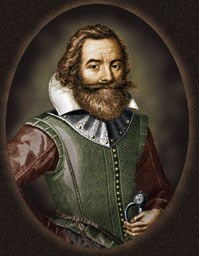
John Smith Map of 1616 (colorized by Preservation Virginia). Captain John Smith was an adventurer, soldier, explorer and author. Through the telling of his early life, we can trace the developments of a man who became a dominate force in the eventual success of Jamestown and the establishment of its legacy as the first permanent English settlement in North America. As a young boy, John attended local grammar schools learning reading, writing, arithmetic, and Latin. Not wanting to be a farmer, John ran away at age 13 to become a sailor, but his father stopped him, making John work as an apprentice [a person who works for another in order to learn that trade] to a nearby merchant. In 1596, following the death of his father, John sailed for France and joined English soldiers fighting the Spanish there and in the Netherlands. A truce ended this fighting in 1598, and John returned to England a trained soldier. 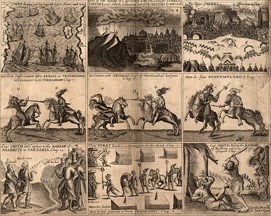
Unknown Artist In 1600, learning of the war being fought between Christian forces of the Holy Roman Empire [HRE] and the Muslim Ottoman Turks, Smith set off for Austria to join the HRE army. On his way to Austria, Smith experienced several adventures, including serving on a pirate ship in the Mediterranean Sea. His pirate service earned him 500 gold pieces enabling him to complete his trip through Italy, Croatia and Slovenia to Austria where he joined the HRE army.
Smith's military exploits impressed prominent men in England, especially Captain Bartholomew Gosnold, a man intent on founding an English colony in the Chesapeake region of Virginia. Gosnold, and other important men in London, organized the Virginia Company of London and were granted a charter by King James I on April 10, 1606, to establish a colony in Virginia. In December 1606, the company dispatched three ships carrying 104 settlers, including Captain John Smith, to start this colony. Established on May 13, 1607, the colony was named Jamestown, in honor of the king. [It became the first permanent English settlement in North America, and first of 13 English colonies that won independence from England and became the first 13 states of the United States of America.] Jamestown's fate hung in the balance for many years, and some historians credit Jamestown's survival to the efforts of Captain Smith. Originally, the colony was governed by a council of seven men, and Captain Smith had been named by the Virginia Company to serve on this council. Ironically, he was arrested for mutiny on the voyage to Virginia, narrowly escaping being hanged, and arrived at Jamestown a prisoner. Fortunately, through the efforts of Jamestown's minister, Reverend Robert Hunt, he was allowed to assume his council position. 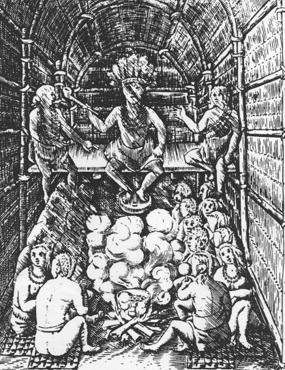
John Smith's Map of 1612. This encounter resulted in the famous story written by Smith of being saved from execution by Pocahontas, Chief Powhatan's daughter. [Most historians and anthropologists believe this event occurred, but Smith misinterpreted its meaning not realizing it was a symbolic adoption ceremony of Smith into the world of the Powhatan people.] The captain was released shortly after the ceremony and escorted back to James Fort. By this time, only 38 of the 104 settlers were still alive. More settlers arrived at Jamestown in January 1608, and Chief Powhatan sent some food to the English, but misfortune struck in early January with the accidental burning down of most of the fort. The extreme cold that winter, coupled with the loss of shelter and food from the fire, led to the deaths of more than half of the new settlers. Smith tried to focus the colonists on their immediate needs and not spend valuable time searching for gold, but he wrote, "There was no talk, no hope, no work but dig gold, wash gold, refine gold, load gold --- such a bruit of GOLD that one mad fellow desired to be buried in the sands, lest they should by their art make gold of his bones!" Despite these fruitless endeavors to find gold, the colony became more stable as additional settlers and food arrived. In the spring of 1608, Captain Smith undertook one of the most important European explorations in North America: the Chesapeake Bay and its tributaries. On two separate voyages, beginning in June and ending in September 1608, Captain Smith and several of his fellow colonists, traveling in an open barge about 30 feet long and 8 feet wide, explored 2,500 miles of the Chesapeake Bay and many of its tributaries such as the Potomac and Rappahannock Rivers. From these trips Smith created a very accurate map of the area replete with locations of various Indian villages and other vital information. This exploration and map of the Chesapeake Bay region were some of Captain Smith's greatest accomplishments and enduring legacies. 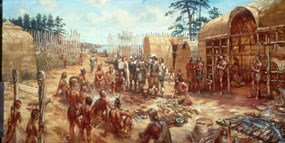
NPS Image. 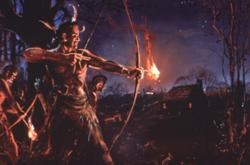
NPS Image Unfortunately, relations were tenuous between the English and the Powhatan Indians as Smith's diplomacy often turned violent taking food and destroying villages. The final meeting of Captain Smith and Chief Powhatan occurred in January 1609 at Werowocomoco, Powhatan's capital, where each leader plotted the other's death while conducting civil negotiations. Ironically, Chief Powhatan's plan to kill Smith and his colleagues was foiled due to a timely warning given Smith by Pocahontas! Each leader escaped destruction, but Smith's harsh diplomacy heightened the animosity between the two cultures and open warfare soon erupted. Captain Smith did not witness the First Anglo Powhatan War [1609-1614] or the Starving Time [winter of 1609-1610] having suffered a severe injury from a gunpowder explosion in the fall of 1609 forcing him to return to England. Smith remained interested in Jamestown wanting to return, but Virginia Company officials refused his requests. Always the adventurer, Smith undertook a voyage in 1614 exploring the shores of northern Virginia, which he mapped and re-named New England. Intending to establish an English colony there, Smith's efforts were frustrated when he was captured by French pirates while sailing to New England in 1615. Escaping from the pirates, Smith returned to England where he wrote extensively about his life's adventures. [In 1620, the Pilgrims nearly selected Captain Smith to be their military advisor but instead selected Miles Standish, however, they did use Smith's map of New England.] Captain John Smith died in London on June 21, 1631, and was buried at St. Sepulchre's Church. 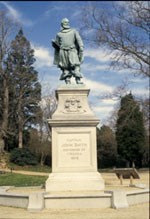
NPS Image. Bibliography
Barbour, Philip. The Three Worlds of Captain John Smith. First. Boston: Houghton Mifflin Company, 1964. Haile (Editor), Edward Wright. Jamestown Narratives: Eyewitness Accounts of the Virginia Colony, The First Decade: 1607-1617. Second. Champlain, Virginia: Round House, 2001. Loker, Aleck. The Adventures of John Smith. First. Greensboro, North Carolina: Morgan Reynolds Publishing, 2006.
|
Last updated: September 4, 2022
